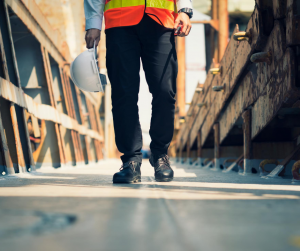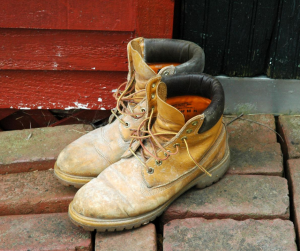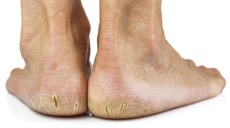
 Tradies – you feel exhausted at the end of your workday, and we get it. Many of you spend a large portion of your day on your feet, moving around, climbing stairs or ladders, operating machinery and generally tiring your body.
Tradies – you feel exhausted at the end of your workday, and we get it. Many of you spend a large portion of your day on your feet, moving around, climbing stairs or ladders, operating machinery and generally tiring your body.
Every step you take can result in significant forces passing through your feet and legs – like a load of up to three times your body weight on your knees. So, it’s no surprise that there are approximately 190 serious workers’ compensation claims made every day – an incidence rate of three times higher than any other occupation.
With 44% of injuries being traumatic joint injuries, 15% being musculoskeletal disorders and 10% being fractures2, the teaFivem at My FootDr spend a lot of time working closely with tradies to help them move without pain, and get back to work comfortably. Today, we’ve shared five common problems we see and treat – and what you should do if they start affecting you today.
1. Safety Boots That Give You Corns, Calluses & Blisters
 Ah, safety boots. We love the protection they offer, but hate that an improper fit can leave you suffering from uncomfortable corns, calluses and blisters. All three of these problems are caused by excess friction to the skin, but in different ways.
Ah, safety boots. We love the protection they offer, but hate that an improper fit can leave you suffering from uncomfortable corns, calluses and blisters. All three of these problems are caused by excess friction to the skin, but in different ways.
Corns and calluses develop when the rubbing or pressure on a specific area of the foot triggers the body’s protective mechanism to thicken the skin – instead of having the skin break down and be vulnerable to infection. The result is a patch of yellow, hard, dead skin that protrudes from the skin’s surface (callus), or a small pebble-like hard patch of skin that extends into the foot (corn) as well as likely being covered by callus.
Blisters more commonly occur on the outside borders of the foot, as it slides up and down an ill-fitting boot. They are more common if your feet are damp, when you are breaking in new shoes – or if you’ve decided to skip the socks for the day. You’ll notice a raised white pocket filled with air or fluid. Always try to keep blisters intact to prevent bacteria from entering the wound. Keep the area clean, and use a dressing while it heals.
Treatment: For corns and calluses, treatment is simple. If you’re in pain, come into your My FootDr clinic to have your podiatrist remove your corns and calluses easily in one appointment. If they’re not yet big enough to cause problems, you can manage them at home by moisturising your feet daily to keep the skin hydrated and supple, and ensuring your boots are correctly fitted to your feet. To help prevent blisters, break in any new boots well by wearing them for shorter periods around the house before spending all day in them at work and choose socks that wick moisture away from your feet.
2. Athlete’s Foot (Tinea Pedis) That Quickly Worsens
Athlete’s Foot is a fungal skin infection that develops on the bottom of the feet and between the toes. It affects the outer layer of the foot and can get very itchy and frustrating. It is contagious and can be difficult to self-treat due to the high rate of reinfection.
Tradies are prone to this problem because fungus thrives and spreads quickly in warm, damp and dark conditions – making the inside of your work boots the perfect breeding ground! Look out for these symptoms:
- Red, scaly or ‘blistery’ patches on the skin
- Dry appearance
- Itching, stinging or burning
- Breakdown of the skin between the toes that may cause painful cracks
Suspect you’ve been housing a fungal skin infection? Treating Athlete’s Foot is done using the right anti-fungal cream or product. You should be confident that you don’t also have a bacterial infection, which may be characterised by a stronger, sweeter smell. You should also check that a fungal nail infection hasn’t taken hold either – these can be much more difficult and time-consuming to treat. If you’re unsure, just see your My FootDr podiatrist!
At home, keep your feet dry and clean as much as possible to help reduce the likelihood of reinfection and help control the infection. High-quality socks designed to wick moisture away and absorbent powders can help. When you get home, always dry your boots out somewhere warm so you avoid wearing damp boots the next day.
3. Sharp Pain At The Base Of Your Heel (Plantar Fasciitis)
 Do you dread those first few steps when you get out of bed in the morning – or when you’re about to stand after a rest?
Do you dread those first few steps when you get out of bed in the morning – or when you’re about to stand after a rest?
Hands-down one of the most common problems we see here at My FootDr, plantar fasciitis is an inflammation of the thick ligament band that runs along the arch, known as the plantar fascia. The inflammation and damage to the fascia manifests as pain at the heel, where the fascia attaches to before spanning out to the toes, hence most people refer to this problem as their ‘heel pain’.
Plantar fasciitis often develops as a result of overloading the foot with excessive impact and pressure from being overused. As a tradie, you’re susceptible because of your long days, the often harder (and less forgiving) surfaces you work on, and the higher forces you’re generally exposed to when completing manual handling tasks.
Unfortunately, treating plantar fasciitis at home is difficult, and the damage to the fascia may worsen if you continue walking on it – which you’ll likely have to for your job. Try stretching your foot before you get out of bed in the morning by pulling the toes towards yourself and holding – this may help your first step pain. Icing the bottom of the feet during flares may also help improve your comfort. To treat plantar fasciitis while helping keep you mobile, active and comfortable on your feet at work, see your My FootDr podiatrist. We have a number of excellent treatments to help kickstart your recovery – including shockwave therapy.
4. Posterior Tibial Tendon Dysfunction (PTTD)
If you’re going to remember one tendon in your lower leg, make it the posterior tibial tendon. This tendon moves from the calves at the back and inside of the lower leg, down below that bony bump (medial malleolus) on the inside of the ankle, and to the foot. It is crucial in supporting the arch, and gently lowering the arch as it rolls down – instead of just letting it slap down onto the ground.
Injury to the tendon is often caused by long-term overuse, high impact forces and plenty of time on the feet, which is common for many tradies. This is especially true if you have a flatter foot type but haven’t done anything to help support the foot and arch. PTTD feels like:
- Pain on the inside of the ankle that may shoot up the leg when walking
- Swelling, stiffness or weakness at the ankle
- Inability to go onto your tiptoes (make sure you hold onto something if trying this!)
- The loss of the arch in the foot, making the foot look flatter
PTTD must be treated together with your podiatrist due to its serious, sensitive and potentially long standing nature. Depending on how severe your injury is, you may require a walker or boot for the initial stages of your repair. Here at My FootDr, we understand that returning to work is important, and will always select the best treatments for you to help you achieve your goals.
5. Forefoot Pain
Pain in the forefoot is another common problem that we see tradies for as it can make working on your feet very unpleasant. As there are a number of causes and underlying problems when it comes to forefoot pain, it’s really important to come in and see us for the right diagnosis if you start feeling any pain or discomfort – especially if it’s affecting your ability to work comfortably. You may have:
- Morton’s Neuroma – painful inflammation around a nerve in your foot that may feel like you’re walking on a pebble. It is often felt between the third and fourth toes and the pain is exacerbated when squeezing the forefoot or wearing tight shoes
- Plantar plate injury – a sprain or a tear to the plantar plate ligament that connects and stabilises the ball of the foot. It can be caused by stubbing your toes or excess pressure to the forefoot over time. You may feel forefoot pain, swelling and may see that two toes move apart like a ‘V’
- Capsulitis or synovitis – capsulitis is the inflammation of a joint capsule following injury, whereas synovitis is the inflammation associated with the synovial membrane that lines the joint. These painful problems often occur at the joints at the ball of the feet when they are placed under excess pressures
My FootDr Have Clinics Australia-Wide
If you are a tradie, pain-free feet and legs are an essential tool for your everyday life. Like any good tool, you need to look after it to keep it working well. If you have any niggles or concerns with your feet or legs, make an appointment to come see us. Our experienced podiatrists can ensure any potential issues are dealt with before they impact your ability to work. My FootDr has clinics across Australia to support you where you need us.
Book your appointment by calling us on 1800 FOOTDR or booking your appointment online here. You can find your nearest My FootDr podiatry centre here.


